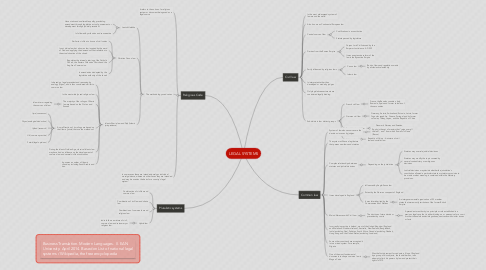
1. Religious Code
1.1. It refers to the notion of a religious system or document being used as a legal source
1.2. The methodology used varies
1.2.1. Jewish Halakha
1.2.1.1. Has a static and unalterable quality, precluding amendment through legislative acts of government or development through judicial precedent
1.2.1.2. Is followed by orthodox and conservative
1.2.2. Christian Canon law
1.2.2.1. Similar to civil law in its use of civil codes
1.2.2.2. Is not divine law, but a human law inspired by the word of God and applying the demands of that revelation to the actual situation of the church.
1.2.2.3. Regulates the internal ordering of the Catholic Church, the Eastern Orthodox Church and the Anglican Communion.
1.2.2.4. Is amended and adapted by the legislative authority of the church
1.2.3. Islamic Sharia law and Fiqh (Islamic jurisprudence)
1.2.3.1. Is based on legal precedent and reasoning by analogy (Qiyas), and is thus considered similar to common law
1.2.3.2. Is the most widely used religious law
1.2.3.3. The majority of the rulings of Sharia law are based on the Qur'an and Sunnah
1.2.3.3.1. Islamic term regarding the sources of Islam
1.2.3.4. A small fraction of its rulings are based on the Ulema (jurists) that use the methods of
1.2.3.4.1. Ijma (consensus)
1.2.3.4.2. Qiyas (analogical deduction)
1.2.3.4.3. Ijtihad (research)
1.2.3.4.4. Urf (common practice)
1.2.3.4.5. Fatwā (legal opinions)
1.2.3.5. During the Islamic Golden Age, classical Islamic law may have had an influence on the development of common law and several civil law institutions
1.2.3.6. It governs a number of Islamic countries, including Saudi Arabia and Iran.
1.3. In some cases these are intended purely as individual moral guidance, whereas in other cases they are intended and may be used as the basis for a country's legal system.
2. Pluralistic systems
2.1. Combination of civil law and common law
2.2. Combination of civil law and sharia law
2.3. Combination of common law and religious law
2.4. Hybrid law
2.4.1. India follows a mixture of civil, common law and customary or religious law.
3. Business Translation. Modern Languages. II. EAN University. April 2014. Based on List of national legal systems / Wikipedia, the free encyclopedia
4. Civil law
4.1. Is the most widespread system of law around the world
4.2. Also known as Continental European law
4.3. Central source of law
4.3.1. Codifications in a constitution
4.3.2. Statute passed by legislature
4.4. Derives from the Roman Empire
4.4.1. Corpus Juris Civilis issued by the Emperor Justinian ca. AD 529
4.4.2. It was an extensive reform of the law in the Byzantine Empire
4.5. Partly influenced by religious laws
4.5.1. Canon law
4.5.1.1. Body of laws and regulations made by ecclesiastical authority
4.5.2. Islamic law
4.6. Is interpreted rather than developed or made by judges
4.7. Only legislative enactments are considered legally binding
4.8. Subdivide in four distinct groups
4.8.1. French civil law
4.8.1.1. France, the Benelux countries, Italy, Romania, Spain and former colonies of those countries
4.8.2. German civil law
4.8.2.1. Germany, Austria, Switzerland, Estonia, Latvia, former Yugoslav republics, Greece, Portugal and its former colonies, Turkey, Japan, and the Republic of China
4.8.3. Scandinavian civil law
4.8.3.1. Denmark, Norway and Sweden, Scandinavian cultural sphere, Finland and Iceland
4.8.4. Chinese law
4.8.4.1. Republic of China - A mixture of civil law and socialist law
5. Common law
5.1. System of law whose sources are the decisions in cases by judges.
5.1.1. Equity is the set of maxims that "reign over all the law”, and “from which flow all civil laws” (Bacon).
5.2. The system will have a legislature that passes new laws and statutes
5.3. Complex relationships between statutes and judicial decisions
5.3.1. Depending on the jurisdiction
5.3.1.1. Statutes may overrule judicial decisions
5.3.1.2. Statutes may modify the topic covered by several contradictory or ambiguous decisions
5.3.1.3. Judicial decisions may decide whether the jurisdiction's constitution allowed a particular statute or statutory provision to be made or what meaning is contained within the statutory provisions.
5.4. It was developed in England
5.4.1. Influenced by Anglo-Saxon law
5.4.2. Extent by the Norman conquest of England
5.4.3. It was later inherited by the Commonwealth of Nations
5.4.3.1. An intergovernmental organisation of 53 member states that were mostly territories of the former British Empire.
5.5. Main differences whit Civil Law
5.5.1. The doctrine of stare decisis or precedent by courts
5.5.1.1. A precedent or authority is a principle or rule established in a previous legal case that is either binding on or persuasive for a court or other tribunal when deciding subsequent cases with similar issues or facts
5.6. Is currently in practice in Ireland, most of the United Kingdom (England and Wales and Northern Ireland), Australia, New Zealand, Bangladesh, India (excluding Goa), Pakistan, South Africa, Canada (excluding Quebec), Hong Kong and the United States (excluding Louisiana)
5.7. Some other countries have accepted it into a mixed system. For example, Nigeria
5.8. One of the most fundamental documents to shape common law is Magna Carta
5.8.1. Was the first document forced onto a King of England by a group of his subjects, the feudal barons, in an attempt to limit his powers by law and protect their rights in 1215.
